View in other NatureServe Network Field Guides
NatureServe
Montana
Utah
Wyoming
Idaho
Wisconsin
British Columbia
South Carolina
Yukon
California
New York
Narrow-winged Grasshopper - Melanoplus angustipennis
Other Names:
Narrow-winged Spur-throat Grasshopper
General Description
The following is taken from Brooks (1958), Vickery and Kevan (1985), Pfadt (2002), Capinera et al. (2004), and Scott (2010). Medium sized, with females slightly larger than males. Dorsal color variable, often dark brown or dark grey, sometimes with a reddish tinge. Abdomen color can be tan or bright yellow. A dark stripe extends from the back of the eye to about two-thirds onto the lateral lobe of the pronotum.
Phenology
Overwinters in egg stage, with the 1st instars appearing during May. They pass through 5 instars, which takes 36 to 42 days to reach the adult stage. Adults occur from early July into October—sometimes to early November (Pfadt 2002) and (Scott 2010).
Diagnostic Characteristics
The following is from Brooks (1958), Vickery and Kevan (1985), Pfadt (2002), Capinera et.al. (2004), and Scott (2010). The body length to end of forewings is 20-24 mm for males, 21-27mm for females. The wings are long and narrow, extending as much as 4 mm beyond the tip of the abdomen. Hind femur is pale yellow with dark markings dorsally on the outer surface. Hind tibia can be red or blue.
Any number of Melanoplus species can be confusing without collecting male specimens for genitalia comparisons to make positive identifications.
Species Range
Montana Range
Range Descriptions
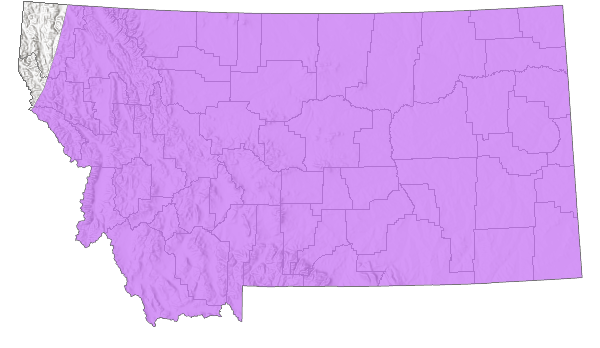
 Native
Native
Range Comments
Widely distributed centrally over North America, extending north to south from southern Canada to Texas, and east to west from the Appalachian Mountains to the Rocky Mountains. In Montana, it can essentially be found throughout the state with over 50% of counties having confirmed occurrence reports (Vickery and Kevan 1985, Pfadt 2002, Capinera et.al. 2004, Scott 2010).
Observations in Montana Natural Heritage Program Database
Number of Observations: 10
(Click on the following maps and charts to see full sized version)
Map Help and Descriptions
Relative Density
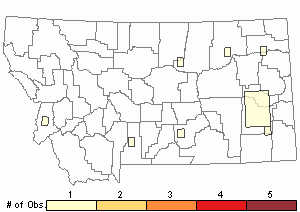
Recency
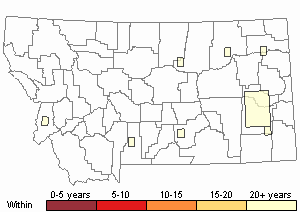
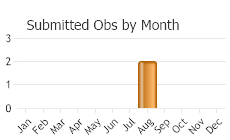
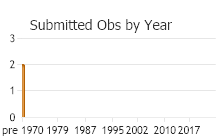 (Observations spanning multiple months or years are excluded from time charts)
(Observations spanning multiple months or years are excluded from time charts)
Habitat
Usually confined to areas of sandy soil with stands of tall, mid, and short grasses and a diversity of forbs; as well as old plowed land and heavily grazed pastures (Capinera and Sechrist 1982 and Pfadt 2002).
Food Habits
This grasshopper is polyphagous, feeding on grasses, forbs, shrubs, moss, fungi and dead insects. It has a preference for forbs. Favored native rangeland species include
western ragweed (
Ambrosia psilostachya), sunflowers,
wavyleaf thistle (
Cirsium undulatum),
flatspine stickseed (
Lappula occidentalis),
white sagebrush (
Artemisia ludoviciana),
blue gramma (
Bouteloua gracilis),
western wheatgrass (
Elymus smithii),
needle-and-thread (
Stipa comata), and
sand dropseed (
Sporobolus cryptandrus) (Capinera and Sechrist 1982 and Pfadt 2002).
Reproductive Characteristics
Egg laying has not been observed in nature. Lab studies, with 8 female caged specimens of this species, indicated that females prefer to lay eggs close to vegetation in sandy soils. They laid a total of 18 pods which consisted of 12 to 17 eggs per pod of those examined. Adult males appear about one week before females. Females reach sexual maturity in about two weeks after fledging to the adult stage. (Pfadt, 2002).
Stewardship Responsibility
References
- Literature Cited AboveLegend:
 View Online Publication
View Online Publication Brooks, A.R. 1958. Acridoidea of Southern Alberta, Saskatchewan, and Manitoba (Orthoptera). The Canadian Entomologist (Supplement 9) 90:5-92.
Brooks, A.R. 1958. Acridoidea of Southern Alberta, Saskatchewan, and Manitoba (Orthoptera). The Canadian Entomologist (Supplement 9) 90:5-92. Capinera, J.L. and T.S. Sechrist. 1982. Grasshoppers of Colorado: Identification, Biology, and Management. Fort Collins, CO: Colorado State University Experiment Station, Bulletin 584S. 161 p.
Capinera, J.L. and T.S. Sechrist. 1982. Grasshoppers of Colorado: Identification, Biology, and Management. Fort Collins, CO: Colorado State University Experiment Station, Bulletin 584S. 161 p. Capinera, J.L., R.D. Scott, and T.J. Walker. 2004. Field Guide to Grasshoppers, Katydids, and Crickets of the United States. Ithaca, NY. Cornell University Press.
Capinera, J.L., R.D. Scott, and T.J. Walker. 2004. Field Guide to Grasshoppers, Katydids, and Crickets of the United States. Ithaca, NY. Cornell University Press. Pfadt, R.E. 2002. Field Guide to Common Western Grasshoppers, 3rd edition. Laramie, WY: Wyoming Agricultural Experiment Station, Bulletin 912, modified by S. Schell and S. Schell for electronic publication. Accessed 19 February 2020. http://www.uwyo.edu/entomology/grasshoppers/field-guide/index.html#fieldguidetoc
Pfadt, R.E. 2002. Field Guide to Common Western Grasshoppers, 3rd edition. Laramie, WY: Wyoming Agricultural Experiment Station, Bulletin 912, modified by S. Schell and S. Schell for electronic publication. Accessed 19 February 2020. http://www.uwyo.edu/entomology/grasshoppers/field-guide/index.html#fieldguidetoc Scott, R.D. 2010. Montana Grasshoppers, Katydids, and Crickets A Pictorial Field Guide to the Orthoptera. MagpieMTGraphics, Billings, MT.
Scott, R.D. 2010. Montana Grasshoppers, Katydids, and Crickets A Pictorial Field Guide to the Orthoptera. MagpieMTGraphics, Billings, MT. Vickery, V. R. and D. K. M. Kevan. 1985. The grasshopper, crickets, and related insects of Canada and adjacent regions. Biosystematics Research Institute, Ottawa, Ontario. Publication Number 1777. 918 pp.
Vickery, V. R. and D. K. M. Kevan. 1985. The grasshopper, crickets, and related insects of Canada and adjacent regions. Biosystematics Research Institute, Ottawa, Ontario. Publication Number 1777. 918 pp.
- Additional ReferencesLegend:
 View Online Publication
View Online Publication
Do you know of a citation we're missing? Bland, R.G. 2003. The Orthoptera of Michigan—Biology, Keys, and Descriptions of Grasshoppers, Katydids, and Crickets. East Lansing, MI: Michigan State University Extension, Bulletin E-2815. 221 p.
Bland, R.G. 2003. The Orthoptera of Michigan—Biology, Keys, and Descriptions of Grasshoppers, Katydids, and Crickets. East Lansing, MI: Michigan State University Extension, Bulletin E-2815. 221 p. Hebard, M. 1928. The Orthoptera of Montana. Proceedings of the Academy of Natural Sciences of Philadelphia, Vol. 80:211-306.
Hebard, M. 1928. The Orthoptera of Montana. Proceedings of the Academy of Natural Sciences of Philadelphia, Vol. 80:211-306. Hebard, M. 1932. Notes on Montana Orthoptera. Proceedings of the Academy of Natural Sciences of Philadelphia. V. 84. pp 251-257.
Hebard, M. 1932. Notes on Montana Orthoptera. Proceedings of the Academy of Natural Sciences of Philadelphia. V. 84. pp 251-257. Kirk, K. and C.R. Bomar. 2005. Guide to the grasshoppers of Wisconsin. Madison, WI: Wisconsin Department of Natural Resources, Bureau of Integrated Science Services PUB-SS-1008. 154 p.
Kirk, K. and C.R. Bomar. 2005. Guide to the grasshoppers of Wisconsin. Madison, WI: Wisconsin Department of Natural Resources, Bureau of Integrated Science Services PUB-SS-1008. 154 p. Skinner, K.F. 1995. Plant and grasshopper community composition: indicators & interactions across three spatial scales. M.Sc. Thesis. Bozeman, MT: Montana State University. 144 p.
Skinner, K.F. 1995. Plant and grasshopper community composition: indicators & interactions across three spatial scales. M.Sc. Thesis. Bozeman, MT: Montana State University. 144 p.
- Web Search Engines for Articles on "Narrow-winged Grasshopper"
- Additional Sources of Information Related to "Insects"





